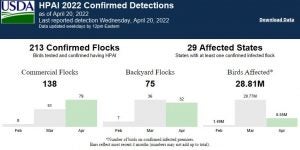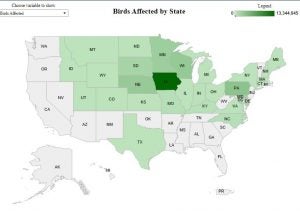With highly pathogenic avian influenza (HPAI) confirmed in wild birds and domestic flocks in 29 states across the country, Michigan animal and wildlife health experts in the departments of Natural Resources and Agriculture and Rural Development are suggesting temporary removal of bird feeders could help mitigate potential spread of the disease.
According to Michigan Farm Bureau, state officials say they’re fielding calls from residents asking how best to keep themselves, their poultry flocks and wild bird populations safe. It’s a timely question too, as popular passerines (perching) species of birds including robins, finches, and sparrows make the spring migration North and seek out food sources such as backyard bird feeders.

Megan Moriarty, the state wildlife veterinarian with the DNR, said it is important to note that while all birds are potentially susceptible to HPAI, some are more likely than others to become infected and die. Domestic birds and some wild birds, like waterfowl, raptors and scavengers, are highly susceptible and have been particularly affected by the disease.
“Current research suggests songbirds are less susceptible to highly pathogenic avian influenza and are unlikely to play a significant role in spreading the virus,” Moriarty said. “However, much remains unknown, and surveillance and testing for HPAI in this group of birds is less common, resulting in a knowledge gap.”
One easy way the public can help reduce the potential spread of HPAI is to remove outdoor bird feeders, Moriarty said. Though there isn’t yet any widespread recommendation from state agencies to do so, temporary removal of bird feeders could be helpful, especially for anyone who has highly susceptible species — domestic poultry, raptors or waterfowl — living nearby.
Similarly, removal could be a wise choice for those who observe high-risk species like blue jays, crows or ravens hanging around backyard bird feeders. Temporary removal of bird feeders and baths may only last for the next couple months, or until the rate of HPAI spread in wild and domestic birds decreases.
“If you’re concerned about this virus and want to act from a place of abundant caution, removing your bird feeders for now makes sense, but it isn’t yet a critical step,” Moriarty said.
“With warmer springtime weather on the way, birds will have more natural food sources readily available to them, so chances are many people will be taking down feeders in a few weeks anyway,” she added.
HPAI in domestic flocks
HPAI is highly contagious and can be spread to domestic flocks by wild birds through contact with infected poultry, by equipment, and on the clothing and shoes of caretakers.
Making sure domestic poultry (e.g., chickens, turkeys, geese and ducks raised for the production of meat or eggs) are isolated from and have no contact with wild birds is essential, according to Michigan State Veterinarian Nora Wineland.
“It is vital for poultry owners to take every step possible to keep wild birds away from their flocks and follow other biosecurity measures,” Wineland said. “Simple, yet effective mitigation strategies help protect not only your flock but others around the state.”

Monitoring and reporting HPAI
If people choose to continue using their bird feeders, keep this guidance in mind:
- Thoroughly clean bird feeders with a diluted bleach solution (and rinse well) once per week. Regularly cleaning helps protect birds against other infections, including salmonella.
- Clean up birdseed that has fallen below the feeders to discourage large numbers of birds and other wildlife from congregating in a concentrated area.
- Don’t feed wild birds, especially waterfowl, near domestic flocks.
Domestic bird owners and caretakers should watch for unusual deaths, decreased egg production, a significant decrease in water consumption or an increase in sick birds.
According to the U.S. Centers for Disease Control and Prevention, HPAI does not present an immediate public health concern. No human cases of this strain of HPAI virus have been detected in the United States. No birds or bird products infected with HPAI will enter the food chain. As a reminder, all poultry and eggs should be handled and cooked properly, with a safe cooking temperature of 165 degrees Fahrenheit.


